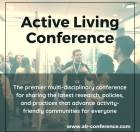We are pleased to announce an exciting new alliance between Active Living Research and GP RED to co-host and coordinate...
Healthy & Active Communities: A Foundation's Response to the Obesity Epidemic
Presentation at the 2009 Active Living Research Annual Conference
Background:
Missouri currently has the 15th highest rate of overweight youth in the US and the 12th highest rate of adult obesity. In 2007, 12% of Missouri youth were reportedly obese. Physical activity and dietary habits for youth in Missouri parallel findings on a national level; nearly 82% of youth consume fewer than 5 fruit/vegetable servings per day while more than half do not meet physical activity recommendations (56.5%).
The Missouri Foundation for Health (MFH) is the second largest health conversion foundation in the country (assets of $1.3 billion), and the largest health care foundation in the state, providing coverage to nearly 75% of Missouri. With a mission to empower the people of the communities served to achieve equal access to quality health services that promote prevention and encourage healthy behaviors, MFH is in a critical position to create change and curb the growing rates of obesity while furthering prevention efforts.
Objectives:
In 2005, MFH instituted the Healthy and Active Communities Initiative (H&AC) in response to the increased prevalence of obesity among Missourians. Its vision is to: empower communities to increase physical activity and nutrition and influence individual and societal attitudes toward maintaining healthy lifestyles. Special emphasis is placed on initiatives that reach populations at increased risk of developing obesity, particularly youth and low income individuals. H&AC is informed by the socio-ecologic framework, recognizing that successful strategies for obesity prevention must incorporate a comprehensive approach targeting multiple spheres of influence, including built environment and policy.
Methods:
In the past 3 years, H&AC has worked to achieve and expand upon its vision through the following mechanisms:
- Targeted Grantmaking: A portfolio approach - Funding was initially provided for individual-level behavioral interventions, community education activities, access to nutritious foods and physical activity, and promotion of local policy change;
- Targeted Grantmaking: Model Practice Building(MPB)- At the completion of the initial H&AC portfolio grants, a funding mechanism was implemented which allows further investment in select H&AC grantees whose programs demonstrate promise, and feature rigorous evaluation and strategic dissemination plans;
- Innovative Funding: Funding to support expansion or proposal of new strategies for preventing obesity that address community gaps in the socio-ecological framework, using multi-sectoral collaborations and emphasis on aspects of environmental and/or policy change;
- Dissemination Activities: MPB grantees are working with an expert team to develop comprehensive plans for disseminating findings and promoting successful strategies at the state and national level;
- Increased collaboration: H&AC supports collaboration among stakeholders across the state and among grantees through program coaching/peer-to-peer exchanges, an interactive website, technical assistance, and regional collaborative development;
- Policy Activities: Implementation of a statewide policy assessment to establish a baseline of local nutrition and physical activity policies in Missouri, which will be evaluated for effectiveness; and
- Missouri Convergence: In 2008, H&AC has taken the lead in organizing the Missouri Convergence, modeled after the national Healthy Eating Active Living Convergence Project.
Results:
Over $11 million has been invested in 33 H&AC grantees and 10 Model Practice Building grantees. Forty communities have been touched by these efforts. Programs include school-based and after-school initiatives; community gardens; social marketing campaigns; walking trails; worksite-based policies on increasing access to nutrition and physical activity opportunities for staff; and community-based participatory policy development initiatives built on collaborations between local leaders and policy-makers. A vast majority of these programs target children, youth, and families. External qualitative and quantitative evaluation of the initiative and funded programs is ongoing, with initial findings indicating that 84% of grantees have accomplished at least half of their specific objectives, and nearly half (45%) of the grantees have achieved more than their original goals. 50% of grantees have helped to change the way the community works together on public issues, and 64% of grantee programs have led some community members to become new leaders or to become generally more engaged. 60% of the grantees can sustain at least half of program activities post-award.
Conclusions:
Leaders in obesity prevention efforts emphasize the need for multi-faceted approaches to effectively stop the rise in obesity. Both government and the healthcare fields have called on foundations to assist in efforts to mitigate and prevent rising rates of obesity. MFH, through the H&AC initiative, is a model for how a foundation can respond to the needs of the communities it serves. H&AC has been able to simultaneously provide support to local communities for programmatic development, while also identifying and disseminating data on promising programs to contribute to the evidence base, and advocating for change in environment and policy. These collaborative efforts stimulate momentum for change that positively impacts youth, families, community, systems, and society.
STAY UP TO DATE
RECENTLY ADDED TOOLS & RESOURCES
MOVE! A BLOG ABOUT ACTIVE LIVING
The "Active Living Conference" aims to break down research and practice silos and...







